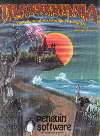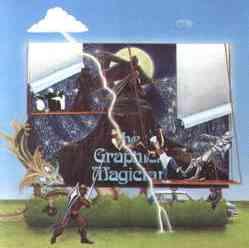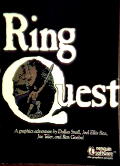Adventure Games
 While we were working on Graphics Magician, a 16-year-old from Ann Arbor, Michigan
sent us a game. It was a text adventure, but he liked Complete Graphics System
and was wondering about how he could add graphics to his adventure game. We happened to
be working on exactly a solution for that, so we sent him an
early development copy of The Graphics Magician, and he produced truly wonderful
graphics for the time. We took Antonio Antiochia's Transylvania game and re-programmed
it using assembly language. And when it was released, it became one of the best graphics "adventure"
type games of its time. The graphics were stunning (for an Apple II) and the game remains a good one today!
While we were working on Graphics Magician, a 16-year-old from Ann Arbor, Michigan
sent us a game. It was a text adventure, but he liked Complete Graphics System
and was wondering about how he could add graphics to his adventure game. We happened to
be working on exactly a solution for that, so we sent him an
early development copy of The Graphics Magician, and he produced truly wonderful
graphics for the time. We took Antonio Antiochia's Transylvania game and re-programmed
it using assembly language. And when it was released, it became one of the best graphics "adventure"
type games of its time. The graphics were stunning (for an Apple II) and the game remains a good one today!
Transylvania was converted into almost every computer format of the time: Apple, Commodore, Atari 800, Atari ST, Amiga... and it was the first program ever released commercially for the Macintosh. In 1984 when the Mac was first introduced, it came with MacWrite and MacPaint. And for the first few months, if you wanted to buy any other software, you could buy the adventure game Transylvania. 1984 was a very good year.
The person behind the Macintosh release of Transylvania was Bob Hardy. Bob was a good friend and a freelance author who lived 2000 miles away in San Luis Obispo, California. We met him at a computer show in San Francisco, and he became one of our most prolific authors. He wrote many of our translations (from one computer to another), but more importantly, he improved each program in the translation process. He was also the person at the front of the booth at a computer show in San Francisco when Robin Williams stopped by to say how much he liked Penguin Software. At the time Mark was at the back of the booth doing a radio interview, but he did notice someone at the booth who looked a lot like "Mork". Surprise... it was!
 Eagle Berns (our Pie Man author, who you can read about on the next page) and his friend Holly
Thomason created a really neat adventure game, The Coveted Mirror. It was one of
our favorite programs because it was well-written in a non-linear manner (as all good
adventure games should be!), it had clever but not ridiculous puzzles, and they also
achieved their goal of making a good, non-violent game.
Eagle Berns (our Pie Man author, who you can read about on the next page) and his friend Holly
Thomason created a really neat adventure game, The Coveted Mirror. It was one of
our favorite programs because it was well-written in a non-linear manner (as all good
adventure games should be!), it had clever but not ridiculous puzzles, and they also
achieved their goal of making a good, non-violent game.
We later released Comprehend versions of both Transylvania and The Coveted Mirror for computers other than the Apple. You can read about the Comprehend series and download those versions on the Comprehend page.

"miraculous and marvelous" - Creative Computing, January 1983
"makes a graphics magician out of each and every Apple user" - Softline, May 1982
"recommended to anyone wanting to work with Apple's high resolution graphics for whatever purpose... definitely a program Apple users should have in their software library" - Byte magazine, November 1982
As Graphics Magician became one of the standards of the software industry, more and more games appeared at our doorstep. Dozens of new programs arrived each week, with authors either asking us to consider publishing their work, or asking for a license to use Graphics Magician. The license was free. All we asked was an acknowledgement that our software routines were used in the end product. By 1983, it seemed that half of the games and educational programs on the market (anything that used graphics) booted up with a "Graphics created with The Graphics Magician" screen. Virtually every other publisher of the time licensed our software for their graphics.
 The Quest, double hi-res edition in DSK archive
The Quest, double hi-res edition in DSK archive
Dallas Snell came to us from Shreveport, Louisiana with a completed adventure game called The Quest that he and friends had created with Graphics Magician. It had some great graphics and a new approach in which you had a sidekick named Gorn who you could instruct to do certain tasks for you. He was rather dumb, but useful in solving some puzzles. Dallas wrote the game with Joe Toler and Joel Ellis Rea. We hedged and toned down some more "mature" themes so as not to be objectionable to the parents of the ten- to twelve-year-old crowd, but it was still the only one of our programs reviewed in Playboy. Ron Goebel joined the development group for the sequel, Ring Quest. Dallas moved from Shreveport to Austin, Texas and went on to be a software producer at Origin Systems. You'll find his name in the credits on the back of some of their better products.





